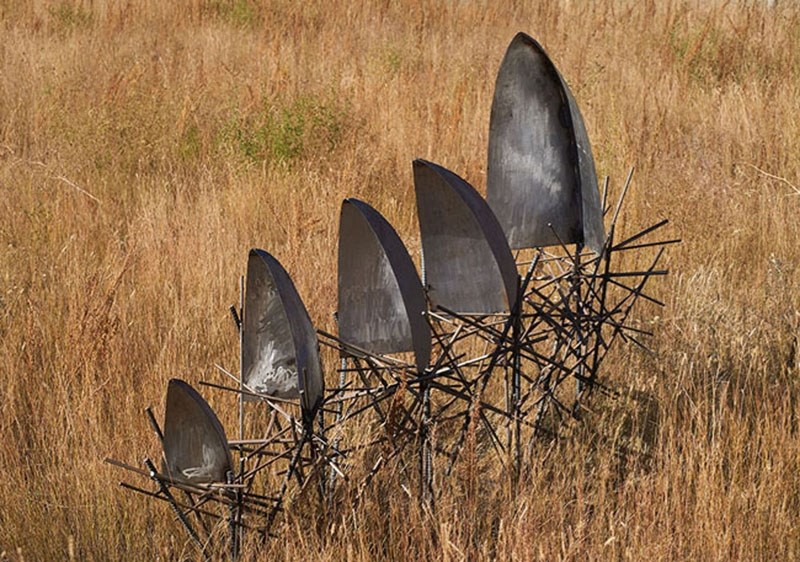There’s a giant iron jawbone of an unknown dinosaur at the Art Gallery of St. Albert. No wait … it’s more like the Sydney Opera House deconstructed and reconstructed with the “sails” prominently displayed all in a row. Clearly, there’s a lot to be said for presentation and personal interpretation.
The piece, actually called Journey, demonstrates not only Saskatchewan artist Bonnie Conly’s interest in portraying the connection between the past and present of the land but also her vast stores of energy to produce art of immense stature and diverse nature.
At first glance, Journey is several feet long and several high at its peak also, no small effort, not to mention its weight borne upon dozens of rebar pieces and those iron teeth/sails. Conly is definitely pouring her heart and soul into this work.
“Some of that welding … it can be quite physical,” she stated, a touch of exhaustion in her voice at the mere thought of the effort.
Maybe that’s the point, or a good part of it. Salvage – the title of her new exhibit coming to the Art Gallery of St. Albert – is about the landscape and the culture that is attached to it. Nothing comes easy, nor does it last forever, but perhaps everything has a chance to be reborn, even on a rebar framework.
Conly talks about how all of it came from her love of the land, specifically in Grasslands National Park, one of the few remaining natural grasslands on the continent and a place that is also designated as a Dark Sky Preserve and has been well-known as a strong candidate for the world’s first designated quiet place too, hence the audio component of Salvage perhaps.
“It’s actually a very noisy place so I have fun with that title. That piece is called Silence. It was noisy all night long with coyotes and a bit of a thunder shower that roared through, then when dawn comes it’s quite amazing,” she began.
“I wanted to give that experience. You do just hear mosquitoes and different kinds of birds. Anyone who has an ear for that will be able to selectively know what they’re hearing.”
Look – nay, listen – for that in the vault of the former bank, a perfect acoustic point for the installation. The videos, on the other hand, are compiled from many hours of footage. She never intended to become a video artist but that’s how the muse moved her, she said.
“I wanted to do drawings. I just ran into three days of the most incredible wind – 70 kilometres an hour. You couldn’t sit out there. It was horrendous, everything was getting blown over. I thought, ‘the whole landscape’s moving, this world’s moving … I need to capture this with video.’ I call them my moving drawings.”
And then there are her sculptures again, including a series of 100 figurines she calls Warriors. Just like Journey, the metal raw materials came primarily from found objects she discovered from old farmsteads or other human habitations since abandoned, land replete with the detritus of determined work that somehow succumbed to the weather or time or other.
She did an artist residency in the south of the province where the national park is, staying on a photographer’s property where the previous owners had made a good go of things.
“There was shop after shop after shop of stuff and littered everywhere. I literally would walk everywhere and pick up metal, all kinds of big pieces and little pieces. We say ‘the land won’. They basically walked away with just what they could carry. Some people left dishes in the sink.”
She described the Warriors in much the same way as the Chinese Terracotta army, with her sculptures serving as stoic observers of the changing land yet protecting the connection that links the past with the present.
“There’s different things that symbolically mean something to me, but I really love and find it quite interesting that people can come and make their own connections to it.”
And that’s when I see Journey in a new light: those sails have become rolling hills weathered by the wind like sand dunes. The rebar framework is important here too, as what lies beneath the surface is just as important to a landscape as soil is to a farmer.
Preview
Salvage<br />metal sculptures, audio and video installations by Bonnie Conly<br />Exhibit runs from Thurs., Feb. 4 to Sat., Feb. 27<br />Opening reception tomorrow from 6 to 8:30 p.m. <br />The artist will be in attendance.<br />Conly will give a presentation at 6:30 p.m.<br />Art Gallery of St. Albert<br />19 Perron St.<br />Call 780-460-4310 or visit www.artgalleryofstalbert.ca for more information.




